Saturated vs Unsaturated Fats
Medical review by Albert J. Hart, MD
Saturated vs unsaturated fats. Which is healthiest? Since fats or fatty acids, their scientific term, constitute the majority of calories you’ll consume on the diet, let's take a look at this question.
There are several types of fats/oils that have different effects on the body. They fall into three major groups according to their chemical structure. These include saturated, monosaturated and polyunsaturated fats. The later two are grouped under the "unsaturated" term.
Saturated Fat
Saturated fats (SFA) have chemical structures in which the chemical bonds of the carbon skeleton are "saturated" with hydrogen. The result is that saturated fatty acid molecules do not react chemically when exposed to air, heat or light; they are stable and not prone to spoil or turn rancid.
Examples include palmitic acid which is found in lard, butter, and coconut oil. Because they are chemically stable, saturated fats cause very little inflammation within the body.
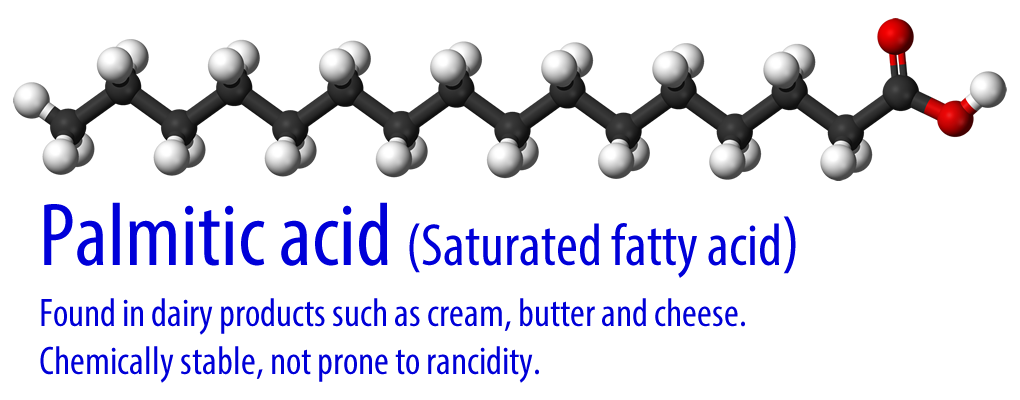
Here's a picture of a palmitic acid molecule. The white balls are hydrogen, the black are carbon, the red are oxygen. The straight configuration allows these molecules to pack together tightly so they can remain solid at room temperature.
Monounsaturated Fat
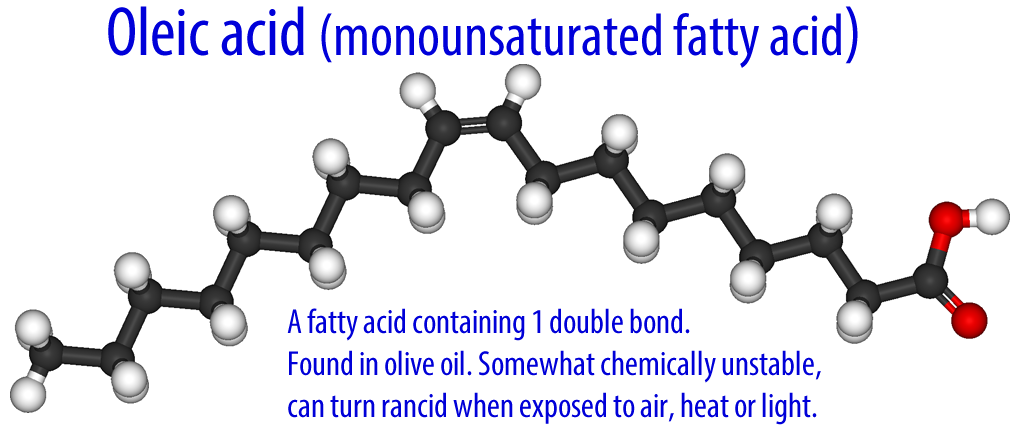
Monounsaturated fats (MUFA) have chemical structures which contain one chemically reactive double bond within a mostly saturated molecule. These fats are somewhat stable, but can go rancid more quickly if exposed to air, heat or light.
Examples include oleic acid which is found in beef tallow and olive oil, avocado, macadamia, and hazelnut oils.
Here's a picture of an oleic acid molecule. Note the molecule bends where the double bond is located. Hence, foods containing large amounts of oleic acid are liquid at room temperature.
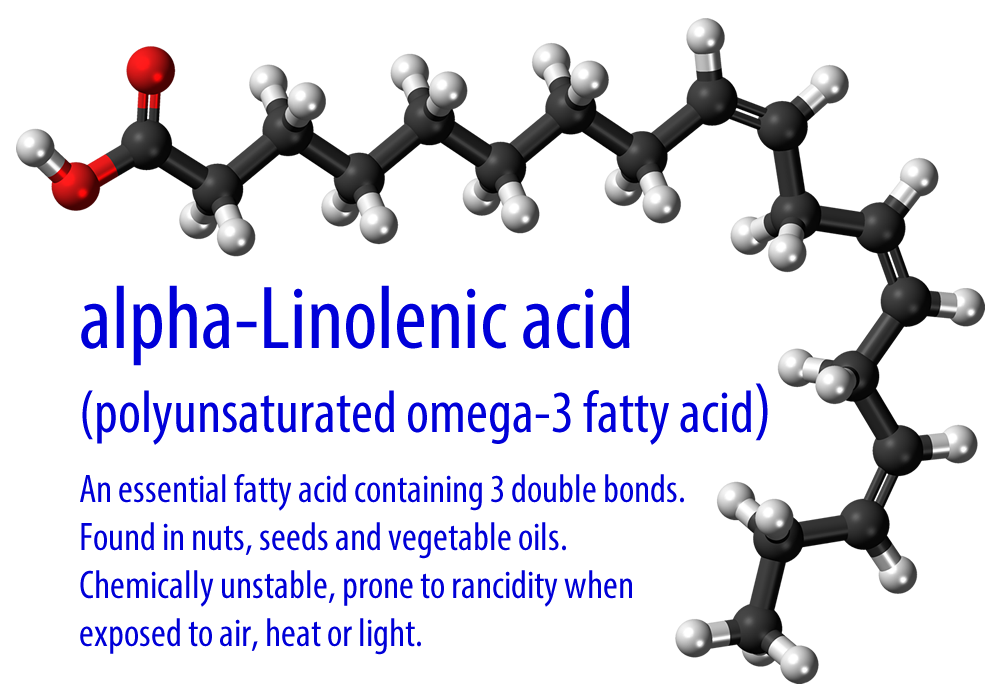
Polyunsaturated Fat
Polyunsaturated fats (PUFA) have chemical structures which have many double bonds. They are the least stable of all the fatty acids, and are prone to rancidity when in contact with air, heat or light. There are two types of PUFAs: omega-6 and omega-3. Omega-6 fats in particular tend to be inflammatory to the body. Somewhat less inflammatory are the now famous omega-3 fats found in fish oil and fatty fish.
Examples of polyunsaturated oils include vegetable oils such as soybean, sunflower and safflower oils which are mostly omega-6 fatty acids. Alpha-linolenic acid (ALA), seen below, is an essential fatty acid that must be obtained from the diet. It is found in nuts, seeds and some vegetable oils. Note has the molecule bends at each double bond, which keeps them from being to pack together tightly. Hence, these fats are liquid at room temperature.
Saturated vs Unsaturated Fats: Which is Best?
Choosing the right fats to eat is important. Since dietary fats will be a prominent part of your daily meals, they should be chosen with digestive tolerance in mind. Saturated and monounsaturated fats such as butter, macadamia nuts, coconut oil, olive oil, avocado, and egg yolks are tolerated more easily.
Most people cannot handle eating large amounts of polyunsaturated fats (PUFA), such as those found in mayonnaise and vegetable oils. Plus these oils are very reactive chemically, so they contribute to free radical activity and inflammation within the body.
In general, in the big picture of saturated vs unsaturated fats, eating more saturated and monounsaturated fats is a good idea. Both are chemically stable to a large extent, so they are less likely to contribute to body inflammation. Replacing saturated fats such as butter with polyunsaturated fats (margarine and vegetable oils) is not beneficial, contrary to what many "experts" will tell you.
Balance Your Polyunsaturated Fat Intake
In addition, your intake of omega-6 fatty acids from vegetable oils should be minimized. This helps you balance your omega-6 intake to your omega-3 fatty acid intake. The balance should be about a 2-1 ratio. Most Americans get way too much omega-6 fat from the processed foods in their diets. Examples of omega-6 PUFA include vegetable oils such as soybean, sunflower, safflower, corn, and canola, plus products containing these oils such as mayonnaise and margarine. Omega-3 fats can be found in fatty fish such as anchovies, sardines, salmon, tuna, and grass-fed meats. In general, you only need a small amount of both omega-6 and omega-3 fats, so taking fish oil supplements in large amounts isn't all that good for you.
A note on most nuts and seeds: with the exception of macadamias, most nuts and seeds are high in omega-6 fatty acids. The jury is still out on whether they should be limited. As they contain many other micronutrients, their omega-6 content may not be problematic. However, determining whether saturated vs. unsaturated (or polyunsaturated) fats are good for a person is an individual thing. I personally get joint soreness if I eat nuts every day. I know people who eat nuts all the time and feel fine.
A good rule of thumb for PUFA fats is to emphasize fish and grass-fed meat in your meals, limit nuts to a few ounces each day, and avoid vegetable oils as much as possible.
Natural Fats versus Trans Fats
Natural fats and cholesterol from animal foods and tropical fats from coconut and palm seeds are nourishing and should never have been disparaged or limited in our diets. But the research on trans fats definitely shows these unnatural fats can cause health problems.
In addition to the vegetable-oil fats mentioned above, trans fats, which are man-made products associated with hydrogenating commercial seed oils should be avoided. These products are included in many processed foods as a substitute for saturated fats (e.g., Crisco).
To avoid these fats, avoid foods with the word “hydrogenated” in the ingredients listed on the label. Many studies that originally implicated naturally occurring saturated fats in heart disease looked at them in combination with trans fats, and it was actually the trans fats that had harmful effects on cardiovascular health. When studied in the absence of man-made trans fats, naturally saturated fats do not cause heart disease.
Trans fats are finally being phased out of our food supply. This is good news because trans fats worsen the risk of heart disease by lowering HDL cholesterol and increasing LDL cholesterol along with another heart-disease risk marker called Lp(a) or lipoprotein(a), a subclass of LDL cholesterol. Trans fats are also associated with an increased risk for stroke and T2DM. The best way to avoid trans fats is to avoid processed foods altogether.
Coconut Oil and MCTs
Coconut oil is a source of fat on a ketogenic diet that has some special properties. In addition to being a source of long-chain fatty acids, it also contains natural medium-chain triglycerides (MCTs). MCTs have a chemical structure that allows them to bypass normal fatty acid digestion pathways. MCTs are passed directly from the intestinal tract to the liver. MCTs are not stored in fat cells, so they must be either burned for energy or converted into ketones by the liver.
The addition of small amounts of coconut oil to your diet will help elevate ketones quickly. However, coconut oil or MCTs can cause diarrhea if over consumed. And despite the fact that MCTs cannot be stored in fat cells, when consumed in excess of calorie needs, they can cause weight gain by diverting long-chain fatty acids to storage in fat cells.
Organic coconut oil is much more available now than it used to be. There are many different brands, and you can buy it online at several Internet stores. Unrefined coconut oil has a strong flavor and odor of coconut. If you prefer a milder flavor, but still wish to experience the benefits of including this MCT-rich oil in your diet, look for “refined” coconut oil.
A Fat List
So in the argument of saturated vs unsaturated fats, it's really better to avoid PUFA and focus on saturated and monounsaturated fats, as they are healthier overall. I've marked each item below as to whether they are mostly saturated (S), monounsaturated (M), or polyunsaturated (P). Avoid hydrogenated fats, such as margarine, to minimize trans fat intake. If you use vegetable oils (canola, sunflower, safflower, soybean, flaxseed, and sesame oils) select “cold-pressed” organic brands and avoid heating them if possible. Keep cold-pressed oils like almond and flaxseed refrigerated to minimize rancidity. Use clean, non-hydrogenated lard, beef tallow, coconut oil, avocado oil, and ghee to fry foods as they have higher smoke points. Many of the unusual fats below can be obtained from various online sources.
- Avocado (M) (count carbs)
- Avocado oil (M)
- Almond oil (P, M)
- Beef tallow, preferably from grass-fed cattle ) (S, M)
- Butter (organic or Kerrygold brands) (S)
- Chicken or duck fat, organic pastured (S, M)
- Ghee (butter with milk solids removed) (S)
- Lard that is not hydrogenated (S, M)
- Macadamia nuts (M)
- Macadamia oil (M)
- Mayonnaise, no or low sugar (Duke’s and Hellmann’s brands are low or no sugar) (P)
- Olive oil, organic (M)
- Olives, green and black (M)
- Organic coconut oil, coconut butter, and coconut-cream concentrate (S)
- Organic red palm oil (S)
- Peanut butter (unsweetened products) and limit the amount consumed due to omega-6 content (P, M)
- Seed and most nut oils (P)
- Dark chocolate (70-90% cacao) can be used in small amounts within carb limits (S, M)
Done with Saturated vs Unsaturated Fats
Back to Ketogenic Diet Plan
All of my books are available in electronic PDF, and now in paperback on Amazon!
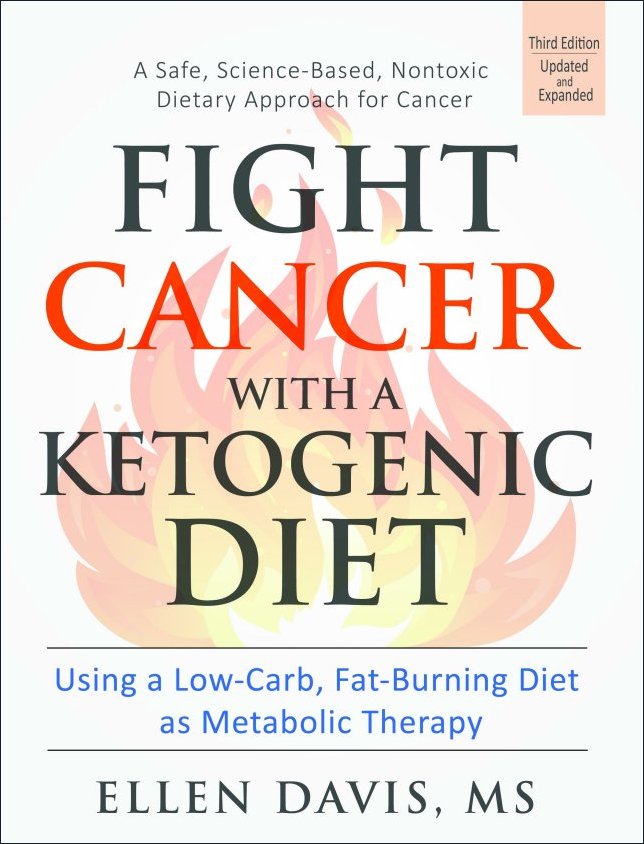 |
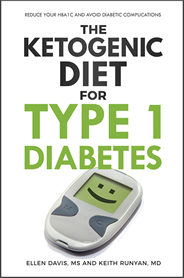 |
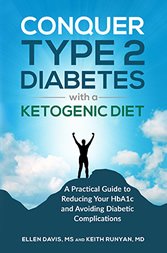 |
|
Buy paperbook on Buy paperback on Amazon Buy the e-Book via Paypal |
Buy paperback on Buy paperback on Amazon Buy the e-Book via Paypal |
Buy paperback on Buy paperback on Amazon Buy the e-Book via PayPal |